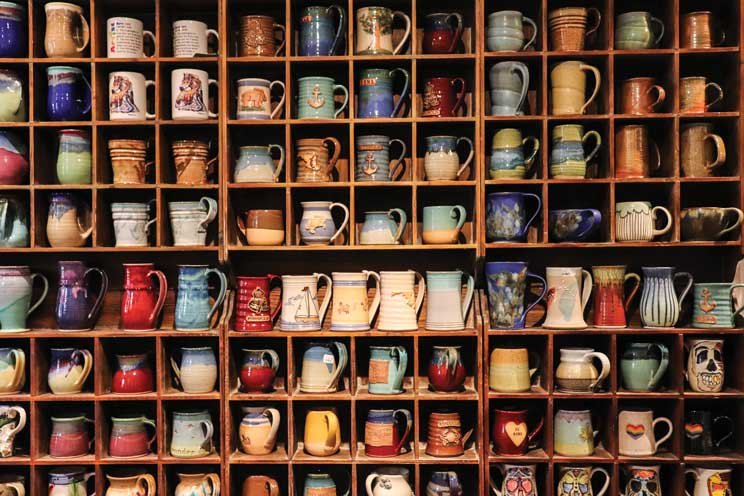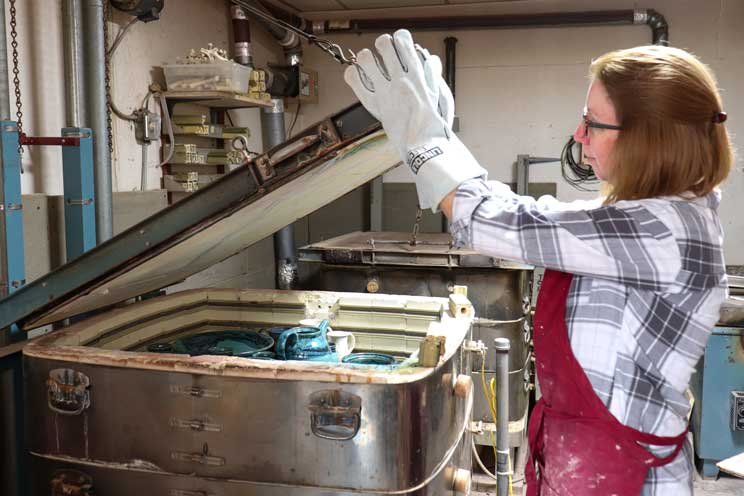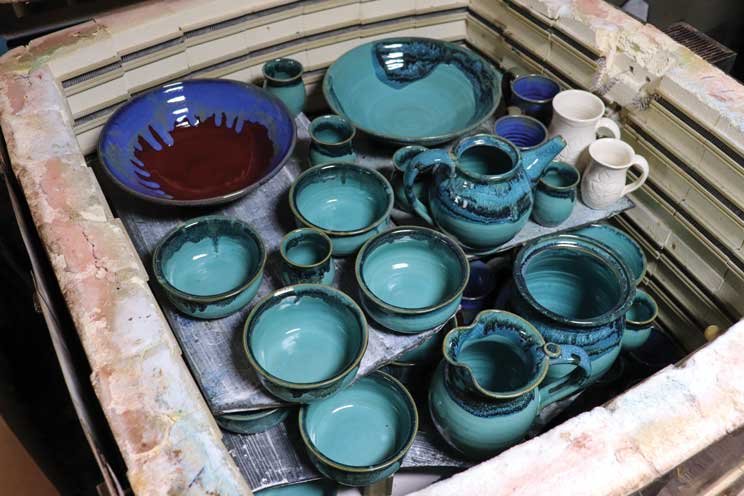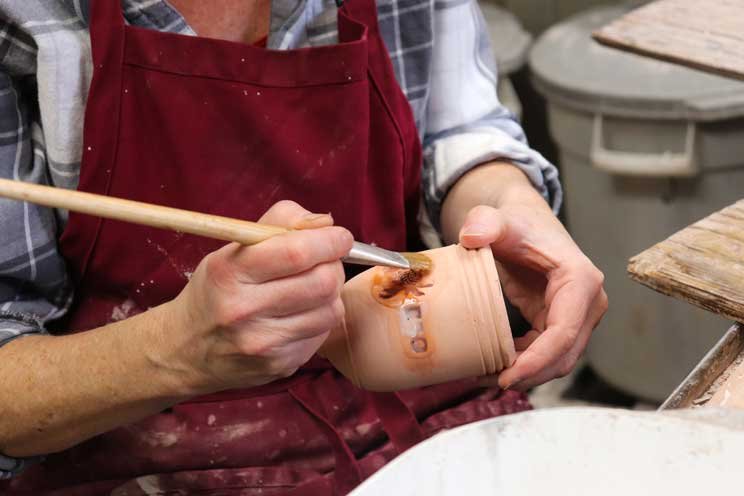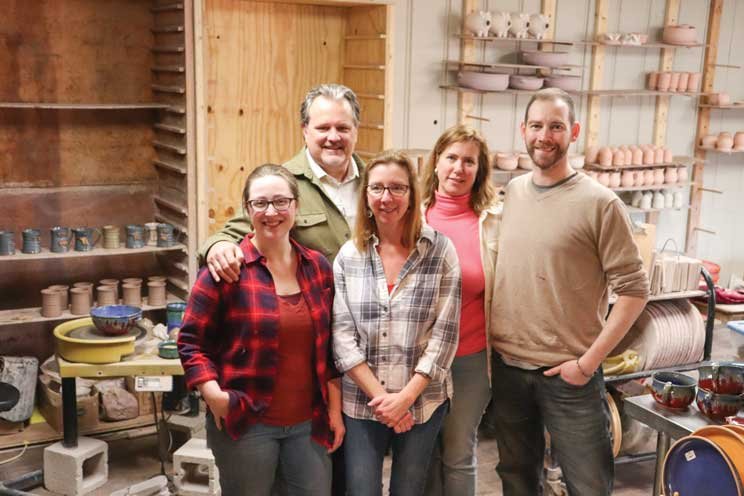+ By Desiree Smith-Daughety + Photos by Elia Alewine (fearless girls photography)
Step through the door of The Annapolis Pottery into a profusion of exuberant colors. Your eyes aren’t sure where to focus, but your brain assesses the scene and directs them. The choice will be as individual as you are.
Melanie Murphy, who has co-owned the business for over a decade with her husband, Patrick, explains that the eye is first drawn to color, then shape. Located on State Circle, across from the Maryland State House, the store is laid out in a systematic way to create moments of serenity amongst the riotous palette.
This is accomplished by grouping together artists’ works as well as the types of pieces that people tend to seek out. Casserole dishes and chowder bowls, for example, are classed together for ease. Though they may have widely different glazes, they share a function.
The experience is a visual whirl, which—with Murphy’s gentle prompting—turns tactile. She urges customers who want a mug, for example, to slip their hands around at least six to see what feels right: the heft, how the handle feels, how comfortable it is to slip your hand around it to hug the base. Not every piece will feel the same, as each has been handmade.
In addition to carrying wares from 70 to 90 artisans and vendors, the store also has artisans on staff who ply their craft in a workshop tucked into a corner of the building. Salmon-toned pieces, newly formed, are stacked on shelves; once dried, they take on a light sienna color, ready for shaping, etching, and other finishing touches before being glazed.
Some works have become signature pieces, a tradition linking the store’s three successive sets of owners. This year marks the store’s fiftieth anniversary, and local inspiration is apparent. Imprints, clay medallions, and whimsical, hand-painted crabs are abundant. One design, molded to resemble an open crab shell, has been created and sold for 25 years. Chowder bowls feature images such as the Liberty Tree or a sailboat, and glazes evoke the area’s waters. There are nods to the store’s hometown, with Annapolis and 1694, the town’s date of establishment, etched onto mugs. Schematics are carefully drawn and, along with production instructions, added to a file that has been maintained throughout the store’s history.
“We’ve kept some of the items the same, but we’re not afraid to embrace change and try new ideas,” says Murphy. For example, in preparing for the semicentennial, a new collection inspired by the earth and water tones of the Severn River has been created.
The Murphys have helmed the business through retail’s rocky disruptions. When they experienced a drop-off of customers who had moved online and weren’t visiting downtown as much, they expanded the business by opening another storefront in Westfield Annapolis Mall—a bold move considering the retail environment. They eventually closed that location, maintaining the State Circle store and starting an online presence. Murphy says, “We have become different consumers because of all the choices available to us, but still, many retailers carry items that all end up looking the same. We provide something different, a mind switch to the ordinary.”
Murphy’s guiding philosophy is a meld of functionality and the endearing qualities inherent in handcrafted pieces. “While making a piece of pottery, the thoughts and actions of the artist’s life go into the interpretation of how the bowl is made,” she says. “Every piece has a story and personal touch.” Recognizing that customers often shop for a piece to serve a particular function, a key design driver is that tactile experience while interacting with the piece. Take a baking dish, for example. How will a person hold it? How will the person feel, pulling it out of the oven—will he or she feel safe? Next, personal aesthetics are added, making a unique ware.
A missed step in the glazing process led to one notable change for the business. There was never a plan to offer a plain white glaze. The pieces they offered were meant to serve as a counterpoint to ubiquitous commercial white or augment the white wares a customer may already have. Murphy relates how iron oxide, a component needed in making a finish to apply, was once inadvertently left out in the process. They decided to proceed without it—and liked the result so much they added white pieces to their offerings. According to Murphy, “We have a lot of happy accidents!”
The store boasts lifetime customers, some of whom were originally tourists in downtown Annapolis who discovered the shop while walking around. Pottery pieces are now shipped internationally, to Japan, Russia, Turkey, and Poland, around South America, and beyond. People will call and say they were in the store and saw a piece they didn’t buy—staff oblige customers struggling to describe those missed opportunities by sending pictures via text and email or providing a virtual tour using Skype. The business also has a very loyal local following that either brings in out-of-town friends or gives pieces as gifts, thereby creating new customers. Mugs are often the entrée into collecting, and individuals return to add a bowl and eventually more pieces.
The Murphys plan to expand the retail space, carving out additional area within the historic building. Murphy shares other plans to celebrate the store’s semicentennial—she’s braiding in a piece of her own personal history. Her grandfather, Percy Crosby, was a cartoonist and fine artist known for creating a cartoon strip featuring the character Skippy. Murphy plans to transfer decals of her grandfather’s fine line drawings onto plates, and their schematics will be added to the file that captures the artistic essence of this iconic store’s long history.

Murphy, who initially had reservations about buying a business involving retail, exudes the passion shaped by her hands-on experience in the business. For example, she will visualize something and relate her vision to the artisans in the workshop, who then immediately bring it into existence. Says Murphy, “There’s that reward you don’t get from working for others.” █

